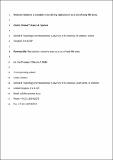Files in this item
Reduced resistance to oxidative stress during reproduction as a cost of early-life stress
Item metadata
| dc.contributor.author | Zimmer, C. | |
| dc.contributor.author | Spencer, K.A. | |
| dc.date.accessioned | 2016-01-05T10:06:53Z | |
| dc.date.available | 2016-01-05T10:06:53Z | |
| dc.date.issued | 2015-05 | |
| dc.identifier | 163900957 | |
| dc.identifier | 40630c4b-c106-4abe-bcb4-f913f818f4fe | |
| dc.identifier | 84920672464 | |
| dc.identifier | 000353734200002 | |
| dc.identifier.citation | Zimmer , C & Spencer , K A 2015 , ' Reduced resistance to oxidative stress during reproduction as a cost of early-life stress ' , Comparative Biochemistry and Physiology Part A: Molecular & Integrative Physiology , vol. 183 , pp. 9-13 . https://doi.org/10.1016/j.cbpa.2014.12.032 | en |
| dc.identifier.issn | 1095-6433 | |
| dc.identifier.other | ORCID: /0000-0002-2851-9379/work/78204965 | |
| dc.identifier.uri | https://hdl.handle.net/10023/7955 | |
| dc.description | This study was funded by a BBSRC David Phillips Research Fellowship to K.A. Spencer. | en |
| dc.description.abstract | Stress exposure during early-life development can have long-term consequences for a variety of biological functions including oxidative stress. The link between early-life stress and oxidative balance is beginning to be explored and previous studies have focused on this link in adult non-breeding or immature individuals. However, as oxidative stress is considered as the main physiological mechanism underlying the trade-off between self-maintenance and investment in reproduction, it is necessary to look at the consequences of early-life stress on oxidative status during reproduction. Here, we investigated the effects of exposure to pre- and/or post-natal stress on oxidative balance during reproduction under benign or stressful environmental conditions in an avian model species, the Japanese quail. We determined total antioxidant status (TAS), total oxidant status (TOS) and resistance to a free-radical attack in individual exposed to pre-natal stress, post-natal stress or both and in control individuals exposed to none of the stressors. TAS levels decreased over time in all females that reproduced under stressful conditions. TOS decreased between the beginning and the end of reproductive period in pre-natal control females. In all females, resistance to a free-radical attack decreased over the reproductive event but this decrease was more pronounced in females from a pre-natal stress development. Our results suggest that pre-natal stress may be associated with a higher cost of reproduction in terms of oxidative stress. These results also confirm that early-life stress can be associated with both benefits and costs depending of the life-history stage or environmental context. | |
| dc.format.extent | 5 | |
| dc.format.extent | 580474 | |
| dc.language.iso | eng | |
| dc.relation.ispartof | Comparative Biochemistry and Physiology Part A: Molecular & Integrative Physiology | en |
| dc.subject | Antioxidant | en |
| dc.subject | Developmental programming | en |
| dc.subject | Early life stress | en |
| dc.subject | Oxidative stress | en |
| dc.subject | Post-natal stress | en |
| dc.subject | Pre-natal stress | en |
| dc.subject | Reactive oxygen species | en |
| dc.subject | Reproduction cost | en |
| dc.subject | BF Psychology | en |
| dc.subject | NDAS | en |
| dc.subject.lcc | BF | en |
| dc.title | Reduced resistance to oxidative stress during reproduction as a cost of early-life stress | en |
| dc.type | Journal article | en |
| dc.contributor.sponsor | BBSRC | en |
| dc.contributor.institution | University of St Andrews. School of Psychology and Neuroscience | en |
| dc.identifier.doi | 10.1016/j.cbpa.2014.12.032 | |
| dc.description.status | Peer reviewed | en |
| dc.date.embargoedUntil | 2015-12-24 | |
| dc.identifier.grantnumber | en |
This item appears in the following Collection(s)
Items in the St Andrews Research Repository are protected by copyright, with all rights reserved, unless otherwise indicated.

